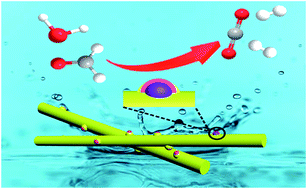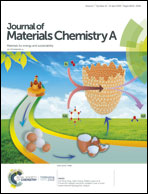Interface engineering of palladium and zinc oxide nanorods with strong metal–support interactions for enhanced hydrogen production from base-free formaldehyde solution†
Abstract
Catalytic hydrogen production from formaldehyde solution provides a promising strategy for future hydrogen-based energy system, while almost all of the present catalytic reactions are carried out in highly alkaline medium. Here, we show the first evidence of the strong metal–support interaction (SMSI) effect between Pd nanoparticles and ZnO nanorods, resulting in the formation of a unique Pd@PdOx/ZnO core–shell structured catalyst as reversible electron transfer occurs between Pd and ZnO. The special synergic effect realizes efficient H2 production from base-free formaldehyde solution. Experimental and theoretical observations indicate that the excellent performance can be attributed to the core–shell catalyst, where the Pd0 shell facilitates Cannizzaro intermediate production, the PdOx site attacks the anionic intermediates, and ZnO activates water splitting. Importantly, the SMSI between Pd and ZnO is able to change the electronic distribution of the catalyst and enhances its Lewis basicity, thereby realizing H2 production from HCHO solution without any base additives. The SMSI effect can be further optimized either by depositing an extra thin ZnO overlayer or by alloying Pd with additional Pt metal to form bimetallic structures that can significantly reduce the activation energy and ultimately improve the catalytic performance. This finding opens a new window to design and develop high performance supported catalysts for catalytic hydrogen production from base-free chemical hydrogen storage chemicals on the basis of precise interface engineering between the metal and the support.



 Please wait while we load your content...
Please wait while we load your content...